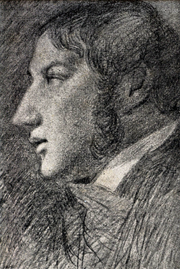| 康斯太勃尔 | |
| 约翰•康斯太勃尔 | |
|
| |

约翰·康斯特勃RA(John Constable/ˈkʌnstəbəl, ˈkɒn-/,1776年6月11日-1837年3月31日),英国风景画画家。他的很多作品描绘的是家乡附近的戴德姆谷风景,此地因此得名“康斯特勃之乡”(Constable Country)。
早年

自画像,1806,泰特美术馆。这是唯一一幅没有争议的康斯特勃自画像,看着镜子画成
康斯特勃出生于泰晤士河河口北面的萨福克郡,父亲是一位磨房主。他的一生非常平淡,他一直在家乡作画,从小酷爱绘画,16岁时因为学校教师太残酷而转学,这位新校长很欣赏他的才华,有时在法语课上发现他在画画,就会停在他身边,然后说:“继续吧,我并没有睡觉,我看你现在是在自己的画室里呢!”,但并不惩罚他。

《戴德姆谷》(The Vale of Dedham),1802,维多利亚和阿尔伯特博物馆
康斯特勃的父亲并不同意他做一个专业的画家,希望他能做一位牧师,但并不反对他画画,由于他不愿意做牧师,就只好让他在磨房中工作,同时他经常画画,画周围熟悉的风景、风车、磨坊,根据他自己回忆,对这些风景的喜爱是他成为画家的主要原因。
1795年,他获得父亲的同意,由一位来访赞赏他才能的画家将他领到伦敦,进入皇家美术学院学习,他想摹仿大师们的风格,但没有成功,发现自己一事无成,甚至想回到家乡干脆做个磨房主算了。
康斯特勃回到家乡,但常徘徊在乡下写生,1802年终于在皇家艺术研究院展出了他的风景画。以后一直到1810年,每年都有作品参展。从1806年前往英格兰北部的湖区旅行两个月,作品的水平越来越高,终于抓住了人们的视线。
成家

玛莉亚·比克内尔,康斯特勃绘于1816年,泰特不列颠藏
他喜欢家乡的青梅竹马的姑娘玛莉亚·伊丽莎白·比克内尔(Maria Elizabeth Bicknell),但姑娘的父亲是乔治四世的律师,家境比他好得多,因此不同意这桩婚事。直到5年后才答应,为了不给姑娘的父亲找到拒绝的借口,他接受了所有订货,大量的工作和精神的疲劳对他的体质起了很坏的影响。1816年他终于和玛莉亚在圣马田教堂结婚,婚后他的妻子为他生了7个孩子。
康斯特勃的父母希望他能做一个肖像画家,可以接受更多的订货,但他没有兴趣,一生中只画过几幅,基本是自画像和他妻子的肖像。他的风景画受到越来越多人们的关注,他自己也从疑虑中解放出来,增加了勇气和自信。1819年他被选为皇家美术学院候补会员,十年后才被选为正式会员。

《干草车》,1821年,国家美术馆藏
1824年,许多外国艺术家参加巴黎沙龙的展览,引起轰动,其中康斯特勃有三幅作品《干草车》、《英国的运河》和《汉普斯戴特的荒地》。法国著名画家德拉克罗瓦刚画完自己的名作《希阿岛的屠杀》送到沙龙,看到康斯特勃的三幅作品后,立即赶回,将《希阿岛的屠杀》上的天空重新绘了一遍,他说:“康斯特勃给了我一个优美的世界”。康斯特勃的《干草车》在巴黎所得的评价甚高,获得了金质奖章,并专门在圣马可大街上开了一个康斯特勃沙龙。

康斯特勃的作品《麦田》

康斯特勃的墓碑
1829年康斯特勃的妻子玛莉亚患结核病去世,对他打击很大。他的生活日趋消沉,再也没有兴趣去寻找新的景色了,经常重绘他年轻时代画过的东西。他回到家乡,忧郁和悲痛的情绪一直笼罩着他,但他从没有停止工作,直到去世,最后一幅作品是《阿伦德尔的磨房和城堡》。此外,直到1835年,他也一直在皇家艺术研究院教课。他死后和妻子一同葬在伦敦汉普斯特德的汉普斯特德圣约翰教堂。
风格
康斯特勃的作品主要是风景画,虽然也绘制国肖像画和宗教主题作品,但实际他对这些都不是很感兴趣。他主张艺术要从观察自然中来,而不是凭空想象。
康斯特勃生前,英国美术界对他并不重视,直到去世后,他的作品才得到赞扬,现在已经成为英国风景画的代表,他的作品把英国的风景画真正从因袭成规和外国影响中摆脱出来,他热爱家乡和大自然,甚至从没有去过苏格兰和威尔士。他像一位田园诗人,但他对后来的画家,尤其是法国的画家影响很大。他有许多独创的技法,如用刮刀直接铺色块,产生闪烁着亮光的白点,表现树叶的反光,这些技法直接影响着巴比松派画家和后来的印象派画家。
参考文献
- ^Parkinson 1998,第9页
- ^Parris,Fleming-Williams & Shields(1976),第59–60页
- ^Parkinson 1998,第15页
- ^Parkinson 1998,第18页
- ^Parkinson 1998,第24页
- ^Parkinson 1998,第33页
- ^Parkinson 1998,第132页
- ^Parkinson 1998,第33页
- ^Parkinson 1998,第50页
- ^Walker 1979
- ^Thornes 1999,第51页
- Bailey, Anthony, John Constable: A Kingdom of His Own, London: Vintage, 2007,ISBN 978-1-84413-833-3
- Constable, Freda, John Constable, Lavenham: Terence Dalton, 1975,ISBN 0-900963-54-9
- Cormack, Malcolm, Constable, Oxford: Phaidon, 1986,ISBN 0-7148-2350-3
- Fleming-Williams, Ian, Constable: Landscape Watercolours & Drawings, London: Tate, 1976,ISBN 0-905005-10-4
- Fleming-Williams, Ian; Parris, Leslie, The Discovery of Constable, London: Hamish Hamilton, 1984,ISBN 0-241-11248-6
- Fraser, John Lloyd, John Constable: 1776–1837, Newton Abbot, UK: Readers Union, 1976,ISBN 0-09-125540-6
- Gayford, Martin, Constable in Love: Love, Landscape, Money and the Making of a Great Painter, Fig Tree, 2009
- Holmes, Charles John, John Constable: Illustrated,Kindle: The Bookmill, 2012,ISBN 978-0-9567303-6-7
- Kelder, Diane, The Great Book of French Impressionism, New York: Abbeville Press, 1980,ISBN 0-89659-151-4
- Leslie, C. R., Mayne, Jonathan, 编, Memoirs of the Life of John Constable, London: Phaidon, 1995,ISBN 0-7148-3360-6
- Lyles,, Anne, editor, Constable: The great landscapes, London: Tate Publishing, 2006,ISBN 1-85437-635-7
- Mayor, A. Hyatt, Prints & People: A Social History of Printed Pictures (nos 455–60), Princeton, N. J.: Princeton University Press, 1980,ISBN 0-691-00326-2
- Parkinson, Ronald, John Constable: The Man and His Art, London: V&A, 1998,ISBN 1-85177-243-X
- Parris, Leslie; Fleming-Williams, Ian, Constable, London: Tate, 1991,ISBN 1-85437-070-7
- Parris, Leslie; Fleming-Williams, Ian, Lionel Constable, London: Tate, 1982,ISBN 0-905005-38-4
- Parris, Leslie; Fleming-Williams, Ian; Shields, Conal, Constable: Paintings, Watercolours & Drawings, London: Tate Gallery, 1976,ISBN 0-905005-15-5
- Pool, Phoebe, John Constable, London: Blandford, 1964,OCLC 3365016
- Reynolds,Graham, Constable: The Natural Painter, St Albans, UK: Panther, 1976,ISBN 0-586-04401-9
- Reynolds, Graham,Constable's England, New York, NY: Metropolitan Museum of Art, 1983,ISBN 9780870993350
- Rhyne, Charles, "The Remarkable Story of the 'Six-Foot Sketches'", Constable: The Great Landscapes, ed. Anne Lyles, London: Tate, 2006,ISBN 978-1-85437-635-0
- Rhyne, Charles, John Constable: Toward a Complete Chronology, Portland, Oregon: Author, 1990,ISBN 0-9627197-0-6
- Rosenthal, Michael, Constable, London: Thames and Hudson, 1987,ISBN 0-500-20211-7
- Rosenthal, Michael, Constable: The Painter and His Landscape, New Haven, CT.: Yale University Press, 1983,ISBN 0-300-03014-2
- Smart, Alastair; Brooks, Attfield, Constable and His Country, London: Elek, 1976,ISBN 0-236-40011-8
- Sunderland, John, Constable, London: Phaidon, 1986,ISBN 978-0-7148-2754-4
- Thornes, John E., John Constable's Skies, Birmingham: University of Birmingham Press, 1999,ISBN 1-902459-02-4
- Vaughan, William, John Constable, London: Tate, 2002,ISBN 1-85437-434-6
- Walker, John, Constable, London: Thames and Hudson, 1979,ISBN 0-500-09133-1
- Wilcox, Timothy, Constable and Salisbury. The soul of landscape, London: Scala, 2011,ISBN 978-1-85759-678-6
John Constable, RA (/ˈkʌnstəbəl, ˈkɒn-/; 11 June 1776 – 31 March 1837) was an English landscape painter in the Romantic tradition. Born in Suffolk, he is known principally for revolutionising the genre of landscape painting with his pictures of Dedham Vale, the area surrounding his home – now known as "Constable Country" – which he invested with an intensity of affection. "I should paint my own places best", he wrote to his friend John Fisher in 1821, "painting is but another word for feeling".
Constable's most famous paintings include Wivenhoe Park (1816), Dedham Vale (1821) and The Hay Wain (1821). Although his paintings are now among the most popular and valuable in British art, he was never financially successful. He became a member of the establishment after he was elected to the Royal Academy at the age of 52. His work was embraced in France, where he sold more than in his native England and inspired the Barbizon school.